Panasonic G1: Smallest and Lightest Interchangeable Lens Digital Camera
by Wesley Fink on September 15, 2008 1:00 PM EST- Posted in
- Digital Camera
Panasonic G1 Press Release
PANASONIC LUMIX DMC-G1: WORLD'S SMALLEST AND LIGHTEST DIGITAL INTERCHANGEABLE LENS CAMERA
World's First Micro Four Thirds System Camera Features Portability, Ease-of-Use and Colorful Blue and Red Models For Personalized Style and Active Lifestyles
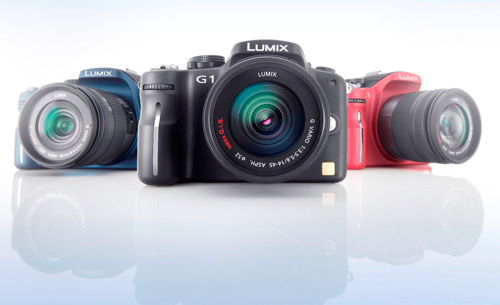
Secaucus, NJ - Panasonic announces the world's first Micro Four Thirds system camera, the LUMIX DMC-G1, the world's smallest and lightest digital interchangeable lens camera, weighing in at approximately 385 grams (0.85 lbs). Based on the new Micro Four Thirds System standard, the LUMIX G1 eliminates the internal mirror structure that defines digital single-lens reflex (DSLR) cameras, thus reducing the size and weight by nearly half. With the mirror-less system, the G1's flange back, which is the distance between the mount and the image sensor, has been reduced from 40mm - as specified in the Four Thirds System - to approximately 20mm.
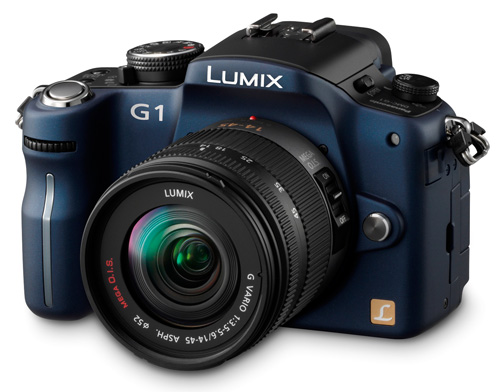
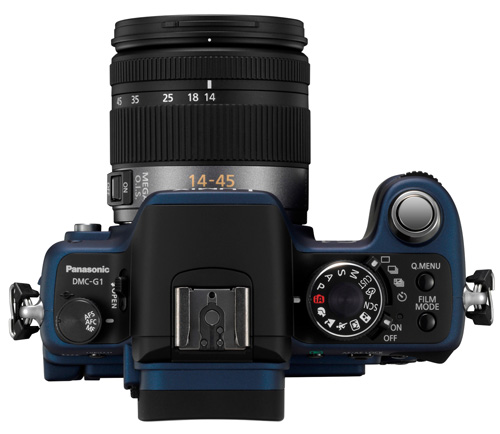
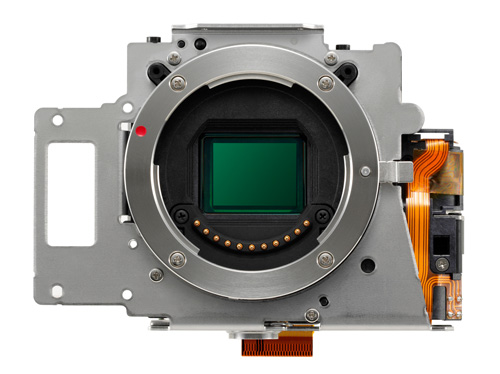
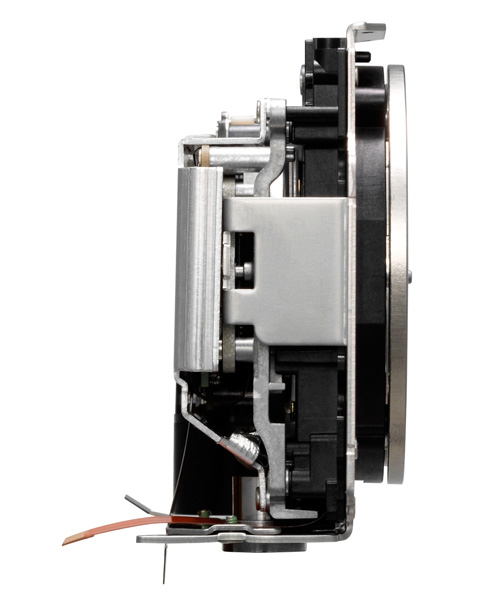
"With the LUMIX G1, we are filling a void that has existed for a long time in the digital camera market, because consumers wanted the power of an SLR, but previous models were bulky and inconvenient," said David Briganti, National Marketing Manager, Imaging, Panasonic Consumer Electronics Company. "The LUMIX G answers this challenge as consumers can benefit from the flexibility of changing lenses; a quick Auto Focus; and a sensor that produces high-quality photos. By packing all those powerful assets into an extremely compact body with easy-to-use features familiar to point-and-shoot users, we are excited about G, as it brings new possibilities to the consumer."
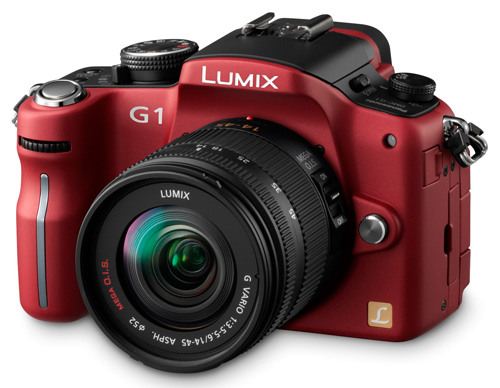
The LUMIX G1 is also the world's first interchangeable lens camera that will come with color variety - with availability in black, blue, and red models - allowing consumers to personalize their style through color, something very popular with point-and-shoot camera models.
For current Four Thirds users with a collection of lenses, an optional mount adapter will allow Four Thirds lenses to be compatible with the LUMIX G1. Also, today, with the introduction of the Micro Four Thirds System, Panasonic is announcing a wide-variety of accessories including: External Flash DMW-FL220 (GN22); PL Filter: DMW-LPL52; Mount Adapter: DMW-MA1; Battery Pack: DMW-BLB13; DC Cable: DMW-DCC3; Soft Case: DMW-CG1; Soft Bag: DMW-BAG1; Shoulder Strap (Stylish) DMW-SSTG1-A/C/R; Shoulder Strap (Woven) DMW-SSTG2-W; Shoulder Strap (Leather) DMW-SSTG3-T. The G1 is also compatible with current accessories: External Flash: DMW-FL360 (GN36)/DMW-FL500 (GN50); ND Filter: DMW-LND52; MC Protector: DMW-LMC52; Remote Shutter: DMW-RSL1; HDMI mini Cable: RP-CDHM15 (1.5m), RP-CDHM30 (3.0m).

The G1's compact size can also be attributed to its electronic full-time Live View Finder, as opposed to a conventional optical viewfinder. The electronic Live View Finder, with an impressive and high-resolution 1,440,000-dot equivalent, allows the user to shoot the exact image the camera sees while also displaying information about the camera's settings through the viewfinder. The G1 also features a clever built-in eye sensor, so the camera can detect when the user is nearing the viewfinder and automatically switches off the LCD, thus conserving battery life. Also, the Live View Finder has a large 1.4x (0.7x on a 35mm equivalent) magnification and when using the G1 in manual focus mode, the frame in the viewfinder or LCD will enlarge by 5x or 10x (can adjust using the dial).
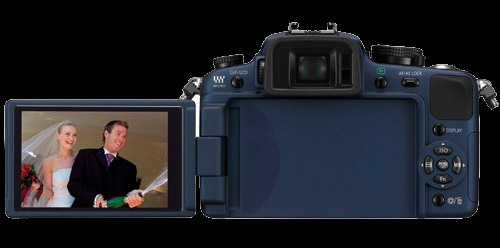
The Live View Finder and the bright 460,000-dot resolution, 3.0" LCD provide a 100% field of view, letting the user adjust settings before taking a shot, which is a great learning tool for consumers beginning to use manual controls, as they can visually confirm the effects of changed settings. The LCD can also swivel 180 degrees horizontally and 270 degrees vertically, giving the consumer flexibility to take high- and low-angle shots, and its Auto Power technology will automatically boost brightness by as much as 40% depending on the shooting condition so it remains visible in all lighting environments.
The G1 introduces a new Contrast AF (Auto Focus) function that is not only accurate and easy to use, but also very fast. Users can choose from a wide-range of AF modes, including multiple-area AF with up to 23 focus areas, 1-area AF with a selectable focus area, Face Detection, and AF Tracking. In the 1-area AF mode, the AF frame size can be changed by simply turning a dial. The G1 also has a Quick AF function that begins focusing as soon as the user aims the camera - no need to wait to press the shutter button halfway. This provides quicker focusing that can help capture the subject before the crucial moment passes.
Users familiar with point-and-shoot digital cameras, and new to the world of advanced interchangeable lens cameras, will benefit from Panasonic's Intelligent Auto (iA) mode. When in iA mode, the G1 will detect the shooting condition and automatically adjust for the ultimate shooting results. Panasonic's iA includes the following intuitive technologies.
- AF Tracking - Automatically tracks the subject as it moves, keeping it in focus without the need to hold the shutter halfway down.
- Intelligent Exposure - Helps prevent photos from being under- or over-exposed by analyzing the framed image and adjusting the brightness in areas that are too dark because of dim lighting, backlighting, or the use of the flash.
- MEGA O.I.S. - Gyrosensors detect hand-shake and the lens system shifts to compensate, helping to prevent hand movement from creating a blurry image.
- Intelligent ISO - Determines if the photo subject is moving and changes the ISO setting and shutter speed accordingly, thus giving a blur-free photo.
- Intelligent Scene Selector - Senses the ambient conditions and will automatically select the appropriate mode from Scenery, Portrait, Close-up, Night Portrait, or Night Scenery.
- Face Detection - Detects faces in the frame (up to 15 faces), even if they are moving, and selects optimal focus and exposure settings so portraits come out clear. Also features Digital Red-Eye correction.
The Panasonic LUMIX DMC-G1, a 12.1MP camera, also includes the following advanced features.
- Live MOS Sensor - Provides the best of both worlds with high image quality from a CCD sensor, and the lower-power consumption of a CMOS sensor. New technology makes it possible to read four channels of data simultaneously and deliver 60 frames-per-second full-time Live View images.
- Venus Engine HD - New imaging processor enhances noise reduction and provides independent gradation control for each of the R, G, and B colors.
- Supersonic Wave Filter Dust Reduction System - Designed to prevent dust from adhering to the image sensor by vibrating 50,000 times per second, the filter repels dust and other particles.
- My Color Mode - Users can freely adjust the color, brightness, and saturation while composing shots, allowing for more expressive and creative shots.
- HDMI Output - With an optional HDMI cable, the G1 can connect to an HDMI-capable High Definition television, such as a Panasonic VIERA Plasma or LCD. When connected to a VIERA, using VIERA Link capability, the TV's remote control can direct the slideshow on the G1.
- My Menu - This new tab automatically stores the five most recently used menu selections for quick, convenient retrieval. The custom-setting can also be used to program a frequently-used function which can be activated by pressing the down arrow on the cursor key. The color of the menu viewed on LCD can also be changed to three different colors: black, red, blue.
Pricing for the Panasonic LUMIX DMC-G1 and its Micro Four Thirds accessories will be announced in early October.










20 Comments
View All Comments
computerfarmer - Thursday, November 27, 2008 - link
There is a detailed review at the following site.http://www.digitalcamerainfo.com/content/Panasonic...">http://www.digitalcamerainfo.com/conten...ix-G1-Di...
It is compared with Nikon D90/D60, Olympus 520, Canon Rebel XSi(450).
I would like to see this camera with the 2 lens kit.
aeternitas - Monday, September 15, 2008 - link
http://www.dpreview.com/previews/panasonicG1">http://www.dpreview.com/previews/panasonicG1whatthehey - Monday, September 15, 2008 - link
It's amazing that no one else can manage to get pre-release digital cameras (particularly DSLR) other than dpreview. I mean, it's almost like they're owned by some company that has early access to hardware, and they use that to gain an advantage. Oh, wait....http://www.dpreview.com/news/0705/07051402amazonac...">http://www.dpreview.com/news/0705/07051402amazonac...
Now the only question is whether their integrity is compromised by the ownership. At the very least, they have an effective monopoly on digital camera previews, which is rather disconcerting. What I don't understand is why the camera companies don't want other sites to get in on the action. It's almost like they're stuck in a pre-digital world trying to figure out how to cope with the internet.
Marketing: "Hey, we should send out a bunch of camera samples to web sites. They'll provide reviews, which are essentially free advertising! All it costs us is shipping plus the hardware, which is a damn sight cheaper than any other form of advertising (and more effective to boot)."
Marketing VP: "HELLS NO! We can't let anyone have early access to our product! It will kill our profits! THINK OF THE CHILDREN!"
Wesley Fink - Monday, September 15, 2008 - link
Thanks for your comment. You certainly understand our frustration in trying to get camera info and samples to review. Frankly we have asked every manufacturer repeatedly, but we have yet to review even ONE camera provided by a manufacturer. We have been buying the cameras wherever we can as fast aswe can and then reselling them after review.The manufacturers keep saying nice things over the last two years, but none of them has ever delivered anything for review. It is still pulling teeth just to get on and remain on, press release lists. This is certainly totally unlike our presence in the computer market and it can be quite frustrating.
We do think our perspective on electronics is quite different from other imaging review sites and we hoped that some manufacturers would see that as a new opportunity for a fair and frank review. Perhaps over time that will eventually happen.
aeternitas - Monday, September 15, 2008 - link
I think it would help manufacturers have a greater trust in the sites review abilities if there was some sort of standard you guys came up with when reviewing them. Resolution cards, constant scenes in consistent lighting that can be taken to show differences in different ISO settings to build a database against other cameras.It has not seemed yet like the reviews have any sort of constants to compare other reviewed cameras here against. Color, sharpness, noise true resolution ect ect. One can put the coolest name they want on their image processor but the outcome is what matters, and it’s too hard to compare totally different scenes with the help of impractical numbers.
Controlled consistant scenes + onmouseover images for the review itself = your friend.
slashbinslashbash - Monday, September 15, 2008 - link
The benefit of SLR's in the film world was obvious. The importance of the "Single Lens" in the "Single Lens Reflex" equation was obvious. What you see in the viewfinder = what will be imaged on the film. In the digital world, with live view screens showing the actual sensor image even more precisely than most optical DSLR viewfinders (only the most expensive have 100% viewfinders), there is no longer any need for the "reflex" part of the "SLR" construction. That whole flipping-mirror thing was just a workaround, a hack, a kludge. Panasonic is the first to realize this, and create a digital camera with interchangeable lenses that opens up the full range of possiblities for digital imaging. The mirror box meant that there would always be a gap of some 20mm (more or less) from the sensor to the back of the lens; thus making lenses with focal lengths of less than approx. 20mm extremely difficult to engineer. Now that the mirror box is gone, the lens can get much closer to the sensor, and hugely wide angles should be attainable, even on a relatively small sensor like the 4/3rds.strikeback03 - Tuesday, September 16, 2008 - link
I don't like any previous EVF I have seen, but I'll reserve judgement on this until I have actually looked at one. The DPR preview said it got grainy when gained up a lot at night, have to see how bad that really is compared to an optical viewfinder. Same with the autofocus - they say it is fast, but I want to see how fast and accurate it is.SLRs typically have a registration distance of around 40mm, this halves that to 20mm. So anything wider than 20mm (which isn't wide on 4/3) will be retrofocal, and to beat the current widest rectilinear lens (Sigma 12-24 on film/FF digital) they will need a lens wider than 6mm.
For whoever said they want a more rangefinder shape, I'm sure that could be done, but their product research probably said the more traditional shape would sell better. Sales of the Olympus E300/E330 were not helped by being a somewhat non-traditional layout.
Maxington - Tuesday, September 16, 2008 - link
" In the digital world, with live view screens showing the actual sensor image even more precisely than most optical DSLR viewfinders"Except electronic viewfinders bring their own parcel of problems.
I just wish they'd stop with the half-assed semi-DSLR body shape and size, and go straight for a very compact, rectangular rangefinder size mobody.
I don't want a slightly smaller DSLR, or I would've bought the Olympus E420. I want a digital rangefinder that doesn't suck and cost the earth like the Leica M8 does.
AnnihilatorX - Tuesday, September 16, 2008 - link
Read the review by dpreview.comI haven't see a single bad thing about live view so far.
Maxington - Wednesday, September 17, 2008 - link
"Read the review by dpreview.comI haven't see a single bad thing about live view so far. "
You try panning fast, or pointing into into bright lights, or darkness.
I've read the Preview of the G1. EVF has advantages, but it also had disadvantages.
I'd kinda like a hybrid OVF/EVF if I could, sort of a heads-up display where it can overlay histograms and other information, but you can disable it if need be. Of course, that still requires a mirror assembly, so its back to DSLR territory anyhow.